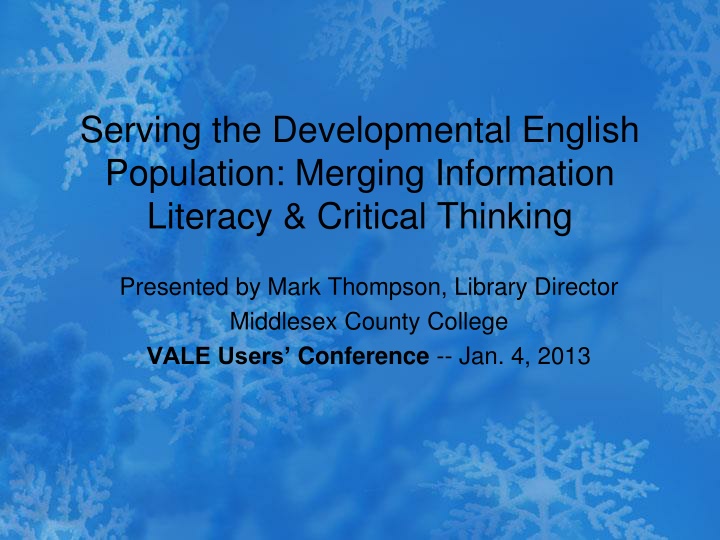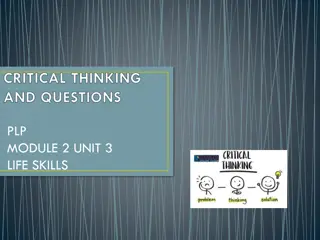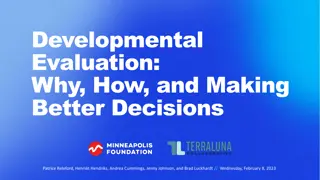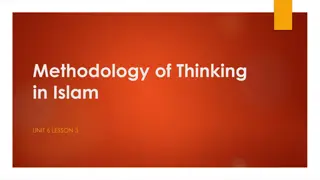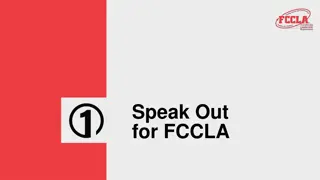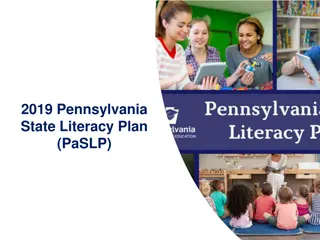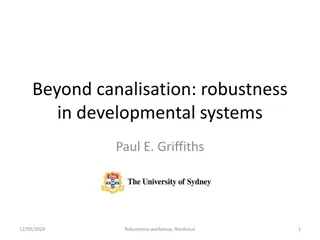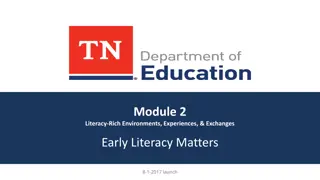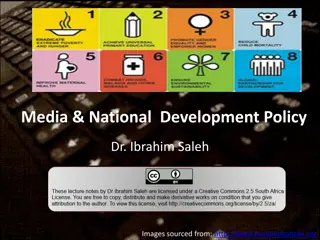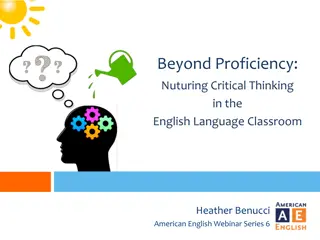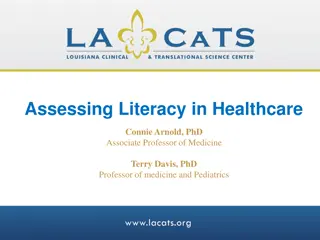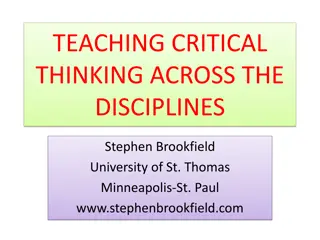Enhancing Information Literacy and Critical Thinking in Developmental English Education
Explore the integration of information literacy and critical thinking skills in serving the developmental English population. Topics include the conceptual framework, practical approaches, issues in critical thinking and information literacy, research findings, and the use of research to stimulate discussions.
Download Presentation

Please find below an Image/Link to download the presentation.
The content on the website is provided AS IS for your information and personal use only. It may not be sold, licensed, or shared on other websites without obtaining consent from the author.If you encounter any issues during the download, it is possible that the publisher has removed the file from their server.
You are allowed to download the files provided on this website for personal or commercial use, subject to the condition that they are used lawfully. All files are the property of their respective owners.
The content on the website is provided AS IS for your information and personal use only. It may not be sold, licensed, or shared on other websites without obtaining consent from the author.
E N D
Presentation Transcript
Serving the Developmental English Population: Merging Information Literacy & Critical Thinking Presented by Mark Thompson, Library Director Middlesex County College VALE Users Conference -- Jan. 4, 2013
Why do this? Critical to info lit success over the student s academic career Key dialogue on campus with academics driven by what THEY talk about Partnership with new ENG chair and work on new Writing Center My ACRL paper (Feb 13) and talk at National ACRL (Apr 13) New research on decision making.
Menu of Topics for Today Discussion of the conceptual framework 4 slides Finding results from current research 4 slides Practical approach to discovery @ your campus 10 slides Practical approach to taking action and revising teaching @ your campus 5 slides
Conceptual Framework: Not Segregated Purpose --Critical Thinking -- Comprehend Communicate Inform --Info Lit-- Activity Read Write Research
Issues: Be able to identify Critical Thinking Evaluating the quality our own thinking and the thinking of others IDEAS: defensible; reasonable; rationale; tested or not Communication Clear, coherent, and well-developed manner Information Literacy Recognize when information is needed and use the ability to locate, evaluate, and use effectively.
Critical Thinking & Info Lit Let s look at the analysis by task Put Excel sheet up
Findings & Research: Cornerstones 1. Info Lit Progression Standards/NJ 2. NJCC General Education Guiding Principles, 9/6/2011. 8 Goal Categories; plus 2 integrated course goals: Information Literacy and Ethical Reasoning 3. NJ Core Curriculum Standards, 2009 www.corestandards.org 4. CLA Common Scoring Rubric: critical thinking, written communication. NY, NY. 5. Partnership for 21st Century Skills, www.p21.org
Research Used to Stimulate Discussions-- The Citation Project research results A New Culture of Learning by Douglas Thomas and John Seely Brown. Thinking, Fast and Slow by Daniel Kahneman. Information Literacy 2.0: Critical Inquiry in the Age of Social Media. by Meredith Farkas (Amer Librar) DIY U: Edupunks, Edupreneurs by Anya Kamenetz. Too Big to Know by David Weinberger.
Starting Point on Critical Thinking www.criticalthinking.org Dr. Richard Paul Founder of the Center for Critical Thinking, Sonoma State U. in northern CA, 1980+ Off shoot is NCECT, National Council
Research is out there Weiner. Is There a Difference Between Critical Thinking and Information Literacy? A Systematic Review 2000-2009. Journal of Information Literacy, 5(2), pp 81-92. Albitz. The What and Who of Information Literacy and Critical Thinking in Higher Education. Portal: Libraries and the Academy. 7(1), 2007. Deitering. Step by Step through the Conversation: A Collaborative Library/Writing Faculty Project to Embed Information Literacy and Promote Critical Thinking in First Year Composition at Oregon State University. Research Paper. www.oregonstate.edu. Detmering. Focusing on the Thinking, Not the Tools: Incorporating Critical Thinking Skills into an information Literacy Module for an Introduction to Business Course. J. of Business & Finance Librarianship, 16:101-107, 2011. Kenedy. Faculty-Librarian Collaboration and the Development of Critical Thinking Skills Through Dynamic Purposeful Learning. Library 61: 116-124, 2011.
Practical Approach: Find the Nitty Gritty Examine teaching practice in light of CT & IL Examine course content, assignments, and needs- Next slide Where are students failing? Ex. Look at textbooks for all levels Find references to readings, assignments, research, essays, and any info lit tasks. SEE Excel chart Look at all course descriptions & syllabi See next slides Compare old & new Student Learning Objectives for exact wording. Notice progression between levels SEE Excel chart
Discovery Phase: Teaching Practice Failure rates in developmental too high Students must take multiple times Critical thinking, comprehension, etc. poor Papers incoherent; poorly sourced Program review / change emphases From grammar, rules, structure to Comprehension, ideas, synthesis Focus on process & reflection Ability to find and synthesize
Textbooks See Excel chart
MCC Example: English Curriculum Reading Skills for College I & II Provides intensive instruction to help students develop basic reading comprehension, vocabulary, communication and study skills. "C" is the minimum acceptable grade for movement from one remedial/developmental level to another and for completion of remediation/developmental requirements to include all credit equivalent courses.
Writing Skills for College I & II ENG 009 = For students whose College Placement Test scores show they need intensive work to improve their writing abilities. Objectives are designed to develop the ability to write in Standard American English. Instruction is provided in sentence structure, punctuation, and usage; students regularly practice writing effective sentences, paragraphs and short essays. ENG 010 = Prerequisite: Appropriate score on the College's Placement Test or a grade of "C" or better in ENG 009. Designed to improve fundamental skills of Standard American English through the writing of effective sentences, paragraphs, and essays and to build confidence in beginning writers. Correct spelling, punctuation and grammar are stressed.
English Composition I Through a variety of writing projects requiring description, characterization, narration, illustration, process analysis, comparison and contrast, and definition, as well as through a documented essay, students develop competence writing clear, correct, effective English prose. Extensive reading materials serve as structural models and as the basis for discussion and for the writing of essays involving response, analysis, and synthesis. During the course, the student will write between 7,000 and 10,000 words, including drafts and revisions
English Composition II Through writings, reading of essays, short stories and poems, and speaking, the student will continue to learn and to practice the skills of clear, correct, effective English. Through a variety of writing projects, requiring techniques such as cause and effect, analysis, evaluation, classification, argumentation and persuasion, as well as through a formal research (library) paper, students will write between 7,000 and 10,000 words, including drafts and revisions. -NEXT SLOs
Taking Joint Action Curriculum Team and Dept Chair Semester launch / training meeting Textbook debates Program review Plans for Writing Center Referrals back & forth between Tutoring / Library Assessments Immediate post info lit class discussion Partner on LibGuides for specific courses
Ways to Merge Efforts Expand on textbook readings Find source of textbook essay find original Find one additional source on topic Using sources: where s the summary? Use database results to test reading: Title / Abstract / Document Conclusion Find keywords in Abstract and convert to search terms comprehension, inference
Conclusions Don t segregate the research and the writing Enlist core reading skills in everything Comprehension & inference Test with titles, abstracts, articles Highlight critical thinking skills used in writing Analyze, synthesize, evaluation Find these elements in an article
Sources / Follow-up Peter Facione. Santa Clara Univ., California Academic Press, 1990. ERIC: ED 315 423 Delphi Report: Critical Thinking-A Statement of Expert Consensus for Purposes of Educational Assessment and Instruction. Go to MCC s libguides: http://middlesexcc.libguides.com/infolit http://middlesexcc.libguides.com/sotl
THANKS Come visit our Edison, NJ campus. We are open to the public. www.middlesexcc.edu Call Mark Thompson at 732-906-2561 Email: mthompson@middlesexcc.edu
